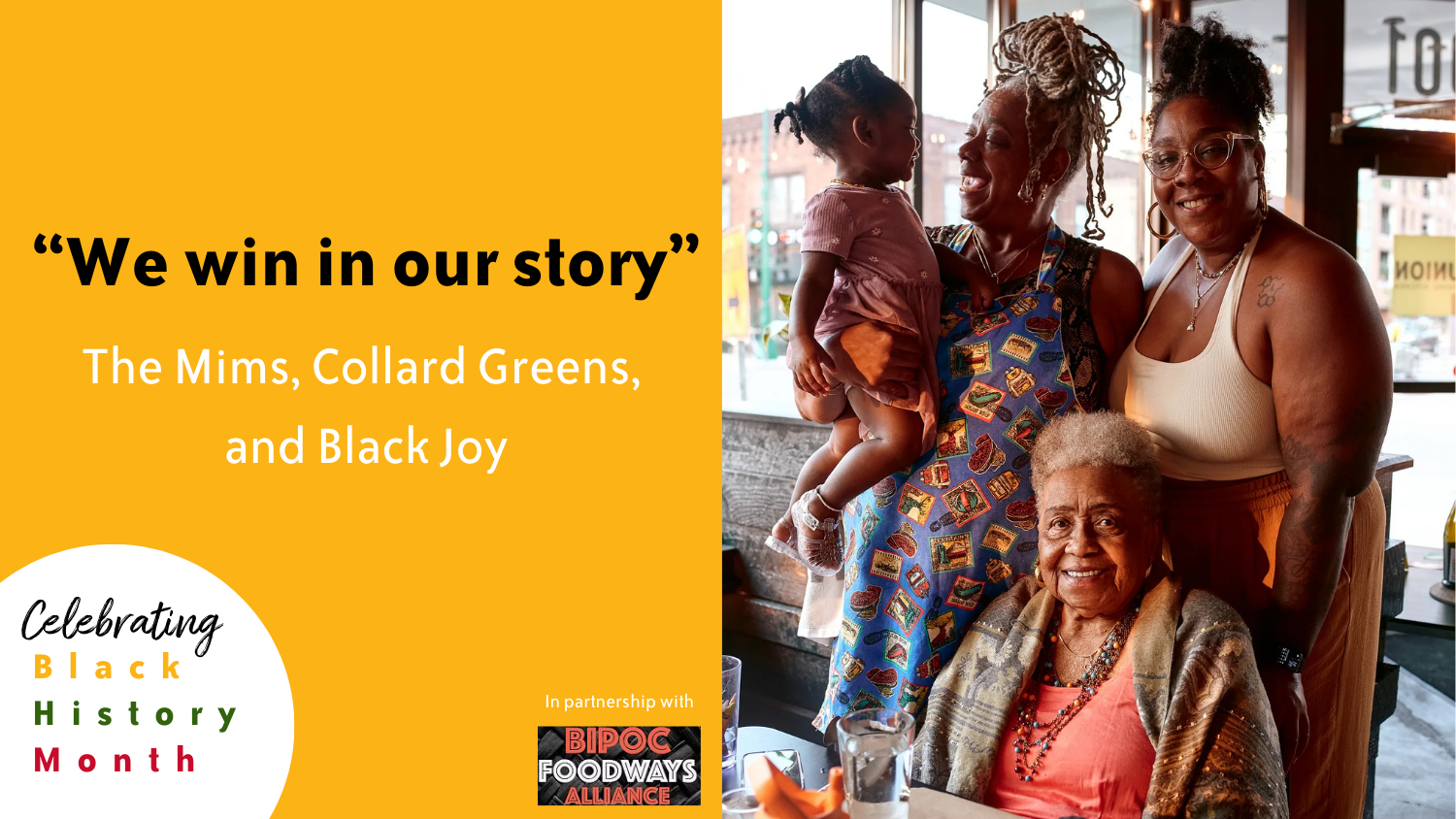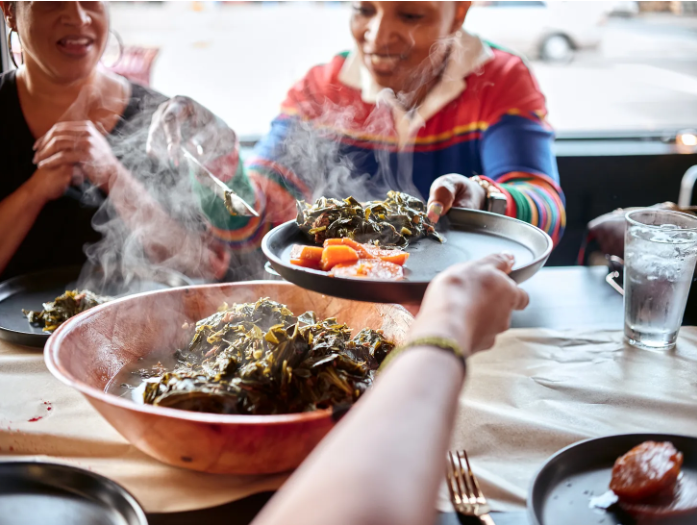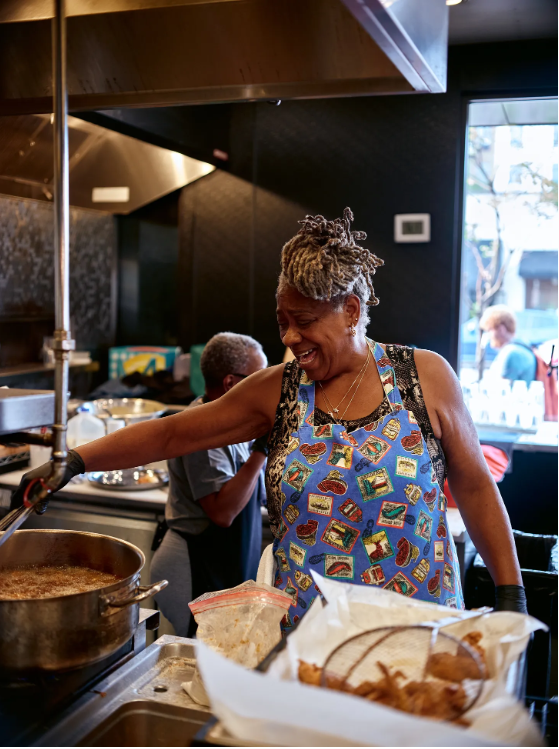
Written by Mecca Bos, Co-founder and Executive Director of BIPOC Foodways
See more of Mecca’s writing here
Don’t miss Vivian Mims’ Award Winning Collard Greens Recipe here!
BIPOC Foodways Alliance uplifts, archives, and shares the stories of people of color– especially stories of women, elders, and immigrant communities– through the lens of home cooking. We break down cultural barriers by inviting an intentionally diverse audience to partake in these stories, leading to empathy, understanding, and antiracism. For Black History Month, we are honoring The Mims, a fourth generation Rondo community family that chooses Black Joy– a condition too often overlooked as part of the Black experience.

Photo: Uche Iroegbu
When you talk about one of The Mims, you have to talk about them all.
“The Mims” are a cohesive, connected, together Black family. Like Black Joy itself, the Mims are an example we see far too little when America presents Black culture. And the Mims want you to know: in their story, they win.
The Mims are anchored by their matriarch, Miss Juanell, 93 years old and going strong, still holding down the multigenerational family home, “A Block,” in St. Paul’s Historically Black Rondo neighborhood. In that household, you’ll also meet Vivian, Vivian’s daughter Benell Weatherspoon, and Benell’s daughter Elaia Sims, all living under the same roof.
“It started out when we were young,” Vivian explains. “That’s just what our mom did, because she had four, and so our oldest brother Medcaw was responsible for me– he was eight years older so he had to take care of his little sister. There’s strength in numbers. In Rondo community it was based in the church, and mom’s affiliations down at Sears. She’d say, “You’re coming down here. I don’t need you by yourself.’ I did my homework, I was in Winnie the Pooh fashion shows, they had a whole cafeteria back in the day, and a candy and popcorn stand in the middle of the store!”
Davvie chimes in: “The whole store smelled like popcorn!”
Davvie lives in Charlotte, but speaks by phone with his family daily.
Juanell was the first Black manager of St. Paul Sears after graduating from Tuskegee institute in the 1950’s. And like many women in the 1950’s, she was also mother to a large family.
And so Juanell was strict– a working mother, she had breakfast on the table for everyone before leaving, dinner on the table when she got home, and sewed everyone’s clothes. She was an excellent seamstress. But Rondo community buttressed her workload.
“That was the southern Black way,” remembers Davvie. Everyone looked out for each other. “And don’t have them [the neighbors] give you a butt whooping— and then [your parents] get home and give you another one! But they also gave you apple pie and a glass of milk in our Rondo— it was a cohesive landing point.”
And so a cohesive landing point was what the Mims always knew, and what they continue to perpetuate for their future generations.
Vivian Mims. Photo: Uche Iroegbu
Juanell and her husband, “Lil David,” (built like a linebacker– nothing little about him) of 41 years met in Alabama where Juanell was attending Tuskegee. They traveled north with the Great Migration, landing in Minnesota where some of the few jobs available to Black men during that time in America– as railroad cooks and porters– were abundant, thanks to the Empire Builder Train stop at Union Station in downtown St. Paul. Many of the families settled in Rondo— more than 80 percent of St. Paul’s Black community once lived in Rondo.
“She was his sweetie,” remembers Vivian. “They also showed us what Black love is, you know. Every Valentine’s Day, no matter where daddy was, mama got a dozen long-stem red roses. No matter where he was, they were delivered to her. He made sure she had Valentine roses. He was young, and she was young, and they started having a family. And, you know, trying to figure it out.”
In the spirit of the family mantra, “stick together,” Davvie remembers his daddy outfitting him in a blazer and disguising him as just another porter so that he could come to work with his dad.
“As long as you had a job nobody noticed. They say all Blacks look alike,” he half-jokes.
It’s a joke that stings. Railroad porter jobs were an extension of slavery and then Jim Crow, beginning as unpaid labor where white passengers would tip, knowing that the porters were limited to working for nothing– it’s the ugly origin story of restaurant tipping culture in the United States.
Davvie uses the experience for characters in Juanell’s Chair, the teleplay he’s co-authoring with Vivian.
“I have a scene right now where characters are able to move around like chess pieces, because nobody even knew what you looked like. Just brown bodies.” Davvie says when he sees the typical Black American story presented in the media, he thinks, “I’ve heard this story a hundred times.” And leaning into the tragedy of the Black American story? That’s not the Mims. “It’s endemic with America– it’s easy to keep people down when you keep telling them that they are down.”
Vivian concurs.
“It’s just so much easier for people to accept the negative narrative about Black culture. It’s like anything bad that happens to you. You know, it resonates with you 50 times more than the positive.”
But that’s not the Mims.
Their joy is anchored in no small part by their traditional Soul Food Sunday Suppers– fried chicken butchered by Vivian using her daddy’s method honed on the railroad, Juanell’s sweet potato pies,yams, cornbread, and of course, no Soul Food table is complete without collard greens.
If “sticking together” is one of the spokes on the wheel of choosing joy, home cooking might be the tread on that wheel.
Juanell continues to hold her family down, in the face of all adversity that America heaps on the Black family. Vivian is transitioning into the role of matriarch-in-waiting, bolstered by the unity home cooking promotes.
“We win in our story,” Davvie concludes.
“This is not about Black people running through the cotton field and finally being liberated. This is a story where Black people are liberated.”


